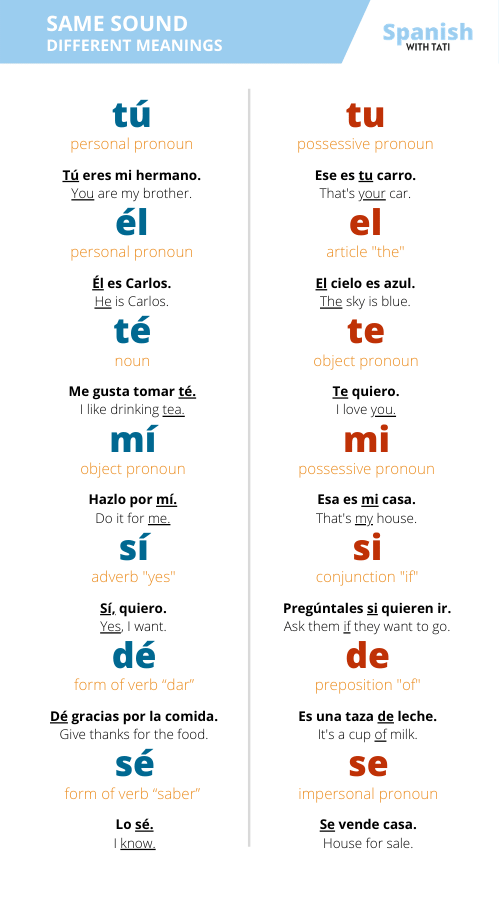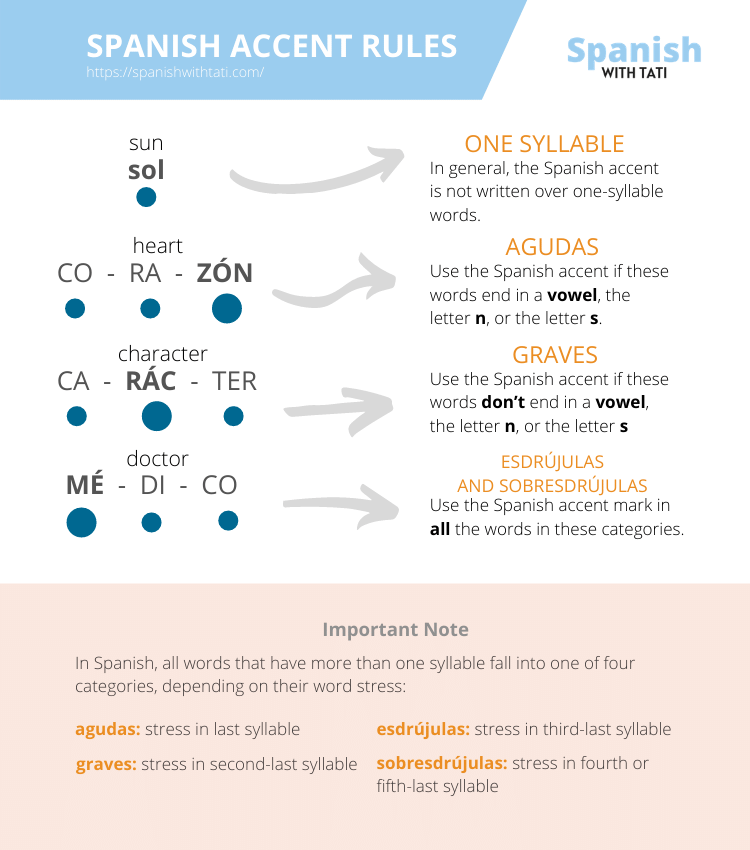Table of Contents
Would you rather have this post in a PDF version? Download it below.
The Spanish Tilde or Accent Mark
The Spanish tilde or accent mark looks like a little slash. It is always written from left to right: á, é, í, ó, ú.
It can only be written over vowels, and it indicates that the vowel over which it is written should be pronounced with emphasis.
Are Spanish tildes important? Yes, they are! The meaning of some words depends on where you place this accent mark within them.
• médico (doctor)
• medicó (he or she gave medication)
The word médico is a noun. On the other hand, the word medicó is a verb. Do you see the accent mark over the vowel o? It means that the verb is in the past.
The preterite is the most used tense in Spanish. Visit the post List of Irregular Preterite Verbs in Spanish to take a look at their conjugations.
So, what do you need to know to be able to use the Spanish accent mark correctly? You need to know two things. Let’s see what they are.
Understanding Word Stress in Spanish
First, to be able to use the Spanish tilde correctly, you need to understand word stress in Spanish.
Word stress refers to where you put the strength of your voice within one word. Words can be divided into syllables, and in one word, not all syllables are pronounced with the same emphasis.
• pa | ya | so (clown)
The word payaso has three syllables, and the stressed syllable is ya, the second-last syllable.
In the word hola, for example, the stressed syllable is ho because it is the syllable that receives the strength of the voice. Ho is pronounced louder, so to speak.
Where should you put the strength of your voice within words? The following 3 rules can help you figure that out.
1. If a word ends in a vowel (a, e, i, o, u) or the consonant n or s, put the strength of your voice on the next to last syllable.
2. If a word ends in any consonant other than n or s, put the strength of your voice on the final syllable.
3. If a word has the Spanish accent mark or tilde, then put the strength of your voice in that syllable, ignoring the rules above.
To learn more about Spanish pronunciation rules, visit the post called Understanding Spanish Pronunciation Rules.
Depending on the position of the strength of the voice within one word, all words in Spanish fall into four different categories or groups whether they are written with the Spanish accent mark or not.
Knowing these categories can help you memorize the Spanish accent rules relatively fast! Let’s learn a bit about these categories.
Important: In Spanish, syllables are count from the end of the word. For example, in the word cerveza (beer), za would be considered the first syllable; ve, the second one; and cer, the third one.
Agudas
The strength of the voice is placed in the last syllable.
• correr
• trabajar
• amistad
Graves or Llanas
The strength of the voice is placed in the second-last syllable.
• palabra
• celeste
• martes
Esdrújulas
The strength of the voice is placed in the third-last syllable.
• teléfono
• relámpago
• rápido
Sobresdrújulas
The strength of the voice is placed in the fourth-last syllable.
• dígamele
• recítenoslo
• llévemelas
That’s it! Those are the four categories. Now, you are ready to dive into the rules to use the Spanish tilde correctly.
The Spanish Accent Mark in Monosyllabic Words
In general, one-syllable words are not written the Spanish accent mark.
• seis (six)
• con (with)
• voy (I go)
• no (not)
• fue (it was)
There is an exception to this rule. Some one-syllable words are identical but have different meanings. To differentiate identical words, an accent mark is written over one of them.
• té (tea)
• te (object pronoun you)
These are the most common identical one-syllable words in Spanish.

The Spanish accent mark used in one-syllable words is called tilde diacrítica because it is used to differentiate words that sound the same but have different meanings.
The Spanish Accent Mark in Multisyllabic Words
Do you remember the word categories agudas, graves, esdrújulas, and sobresdrújulas? We are about to use them!
To use the Spanish tilde or accent mark you will need the following rules.
Tilde in Agudas
Use the Spanish accent mark in an aguda word if it ends with the letter n or s.
Examples:
• corazón
• razón
• compás
• dragón
Use the Spanish accent mark in an aguda word if it ends with a vowel.
Examples:
• comité
• revisó
• colibrí
• iglú
Tilde in Graves
Use the Spanish accent mark in grave words that end with two consonants.
Examples:
• wéstern
• récords
• bíceps
• cíborg
Use the Spanish accent mark in grave words that don’t end with the letters n or s.
Examples:
• dólar
• lápiz
• túnel
• tórax
Don’t use the Spanish accent mark if a grave word ends with a vowel.
Examples:
• lata
• parque
• libro
• tribu
Tilde in Esdrújulas and Sobresdrújulas
Use the Spanish accent mark in all words in which the strength of the voice falls on the third, fourth, or fifth-last syllable.
Examples:
• análisis
• cóselo
• hábitat
• tráelo
• fácilmente
Here’s a little chart that can help you remember these rules!

The Spanish Accent Mark in Question Words
Use the Spanish accent mark in the following words when they are used in questions or exclamatory sentences.
Questions
• qué
¿Qué quieres? (What do you want?)
• cuál
¿Cuál es tu nombre? (What’s your name?)
• quién
¿Quién eres? (Who are you?)
• cómo
¿Cómo te llamas? (What’s your name?)
• cúan
¿Cuán alto eres? (How tall are you?)
• cuánto
¿Cuánto tiempo tienes? (How much time do you have?)
• cuándo
¿Cuándo te vas? (When are you leaving?)
• dónde
¿De dónde eres? (Where are you from?)
• adónde
¿Adónde vas? (Where are you going?)
Exclamatory Sentences
• qué
¡Qué pena! (What a shame!)
• cómo
¡Cómo te agradezco! (I am so grateful!)
To Sum Up, Remember that…
1. In general, the Spanish accent is not used in one-syllable words.
Examples: voy, sol, fui
2. Use the Spanish accent in words in which the strength of the voice falls in the last syllable if they end in a vowel, the letter n, or the letter s.
Examples: colibrí, volé, opción
3. Use the Spanish accent in words that are stressed in the second-last syllable if they end with two consonants or don’t end in a vowel, the letter n, or the letter s.
Examples: récords, dólar, lápiz
4. Use the Spanish accent mark in all the words that are stressed in the third, fourth or fifth-last syllable.
Examples: teléfono, apréndetelo, trágicamente
5. Use the Spanish accent mark in the question words: qué, cuál, quién, cómo, cuán, cuánto, cuándo, dónde, adónde.
Examples: ¿Qué piensas ahora de la tilde en español?
Think this is neat? Share it with your friends!




